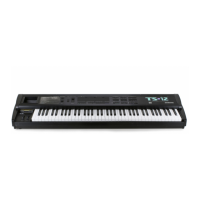Section 7 — Effect Parameters TS-12 Musician’s Manual
20
HF - DAMPING Range: 00 to 99
Increasing the value of this parameter will gradually filter out increasing amounts of high-
frequency energy. Higher values yield an abrupt decay. Controls the cut off of a low pass filter
in series with the decay within the definition.
BANDWIDTH Range: 01 to 99
Acts as a low-pass filter on the output of the plate reverbs, controlling the amount of high
frequencies present. The higher the setting, the more high frequencies are allowed to pass
through, offering a brighter ringing sound. Some interesting effects can be created by using a
mod controller over a large range.
DETUNE - RATE Range: 00 to 99
Controls the LFO rate of detuning incorporated within the reverb. Detuning creates a slight pitch
shift into the reverberated signal, giving it a more natural sounding decay by breaking up
resonant nodes.
DEPTH Range: 00 to 99
Controls the depth of the detuning, that is, how much the pitch will change. Low values yield a
metallic sound. Some voices sound best with very low values.
DEFINITION Range: 00 to 99
Controls the rate at which echo density increases with time. Higher values can cause the echo
density to build at a rate that exceeds the decay rate. Try to select the highest value that works
with your sound source for the best performance.
DIFFUSION Ranges: 00 to 99
The two diffusion parameters smear the input signal to create a smoother sound. Lower values
will cause impulse sounds to appear as a series of discrete echoes, while higher values tend to
increase the smear, making the echoes less apparent.
24 SMALL PLATE REVERB
25 LARGE PLATE REVERB 1
A plate reverb takes the vibrations from a metal plate and uses them to create a metallic sounding
reverb. SMALL PLATE REVERB is a tight sounding plate reverb, and LARGE PLATE REVERB 1
simulates a larger plate reverb. Small plate reverbs are most often used in the studio for drums
and percussion, while large plate reverbs are often used to enhance a vocalist’s performance.
Small Plate Reverb & Large Plate Reverb 1 Signal Routing
Diffuser
Diffuser
L
LPF
Main
Outputs
LPF
R
Definition
(Decay Diffuser)
Definition
(Decay Diffuser)
FX1 Left
FX2 Left
FX1 Right
FX2 Right
These two plate reverb algorithms share exactly the same signal routing topology. The internal
values of the components (not user programmable) differentiate the large and small plate
reverbs. The signal goes directly through the diffusers which smear the signal. The signal is then
routed to a larger diffuser, known as Decay Definition, and is diffused over a period of time

